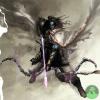I have to say, the machine looks oddly shaped to me.
1) The legs: way to straight. This makes the whole machine look undyanmic IMO. Legs can be bend backwards or forwards, depending on what types of animal / human legs they are based on. Human legs tend to straighten a lot when standing upright in a rest position, but should never be 100% straight. There is a natural flow, a natural S curve to human legs when straightened.
I think the artist call it gesture. When you plan your mecha, you should do a gesture doodle first to see if the lines follow an appealing flow, and the resulting thing look balanced.
2) The body: The short and stocky body looks like it would work well combined with a walker with birds legs bending backward. On a walker/mecha with human legs, IDK. Especially looked at from the front it looks like a head with arms and legs, but no body. Looks weird to me. Of course, problem is that arms and gun just hide the body. But I would make the body longer and more resembling humanoid shape if you go for humanoid legs.
3) Head: The fact that the head is so extremly out of the balance point of the body looks weird to me, because there seems to be no coutnerbalance to head and arms on the back. Might work better with bent bird legs, which could be placed more forward so that the whole thing looks better balanced.
Personally, I would either place the head in the center, humanoid style, ideally combined with a body of more humanoid proportions... or go with a fixed "cockpit" if you go for a walker with such an elongated body.
3) Arms: If the mecha is more the bird legged walker style with the elongated body, I think humanoid like arms with hands look a little bit off. I would rather go with gun turrets instead of arms, or arms ending in weapons instead of hands.
Now, because you have this weird elongated body on your else humanoid-ish mecha, to me the arms carrying a weapon like that looks odd.
I think the concept could work, for me, with a complete remodelling of the body (making it taller and less deep, more humanoid), moving the head back into balance, adding enough counterweight to the back to balance the arm and weapon, and making small alterations to the legs so they look more dynamic.
I wouldn't just bend the knee on a humanoid mecha, unless you want it to look somewhat stiff and awkward. I would keep the legs quite straight, but either add something that would somehow emulate the natural gesture of a human leg. Something that might give the leg a look that resembles the muscles on a human leg. Maybe move the lower leg back a little bit, to give the legs more of a dynamic impression, as it might emulate the S curve a straight human leg forms naturally (have a look at a straight human leg, especially when drawn comicstyle, to see what I mean).
The tail just doesn't work for me. Now, maybe you are not finished here, because it looks way to thin for such a massive machine.
But I would also question what the function of a tail is on such a mecha, given it was mostly used as counterweight on real animals of such gigantic proportions. I would guess there is more than enough "counterweight" packed into the rear part of the body anyway in such a machine? Maybe you could instead just make sure the back is a litle bit fatter, instead of adding a tail (unless its also used as a weapon or something).
Way too much negative sounding critique, I know :) ... but hey, just wanted to point out what stood out for me. Else it looks good to me (apart of the many, many ploygons which probably should be baked into a normal map), so keep up the good work!







